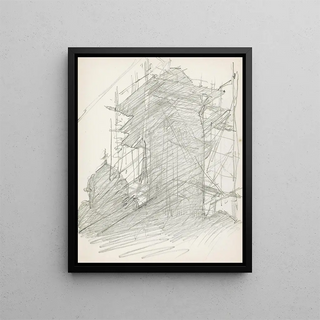Art print | Tour dans un échafaudage - Reijer Stolk


View from behind

Frame (optional)
Tour dans un échafaudage - Reijer Stolk – Captivating introduction
The art print Tour dans un échafaudage - Reijer Stolk immerses us in a universe where art and architecture intersect with striking intensity. This piece, emblematic of Dutch style, evokes not only the beauty of human structures but also the complexity of the emotions they inspire. Through a subtle play of light and shadow, Stolk manages to capture the very essence of urban space, transforming a simple scaffolding into a symbol of creativity and potential. Contemplating this work invites the viewer to reflect on the construction process, both material and intellectual, that shapes our daily environment.
Style and uniqueness of the work
Reijer Stolk's style is distinguished by a realistic approach, tinged with poetic sensitivity. In Tour dans un échafaudage, precise lines and meticulous details create a harmonious composition, where each element finds its place. The artist plays with perspectives, creating an illusion of depth that draws the eye toward infinity. The scaffolding, usually perceived as a simple tool, becomes here a central, almost monumental element. The color palette chosen by Stolk, both soft and vibrant, evokes an atmosphere of calm and contemplation. Shades of gray and beige, enhanced by touches of bright color, breathe new life into this ordinary scene, transforming the banal into the sublime.
The artist and his influence
Reijer Stolk is an artist whose journey is marked by an unceasing quest for authenticity. Trained in classical traditions, he has, over the years, developed a style unique to him, blending contemporary influences with ancient techniques. His work is part of a constant dialogue with his environment, whether it be urban landscapes or scenes of daily life. Stolk is also known for his commitment to preserving architectural heritage, a concern that is evident in his creations. By highlighting structures often neglected, he reminds us of the importance of our cultural legacy and our responsibility toward it. His influence extends beyond borders, inspiring a new generation of artists to explore the

Matte finish

View from behind

Frame (optional)
Tour dans un échafaudage - Reijer Stolk – Captivating introduction
The art print Tour dans un échafaudage - Reijer Stolk immerses us in a universe where art and architecture intersect with striking intensity. This piece, emblematic of Dutch style, evokes not only the beauty of human structures but also the complexity of the emotions they inspire. Through a subtle play of light and shadow, Stolk manages to capture the very essence of urban space, transforming a simple scaffolding into a symbol of creativity and potential. Contemplating this work invites the viewer to reflect on the construction process, both material and intellectual, that shapes our daily environment.
Style and uniqueness of the work
Reijer Stolk's style is distinguished by a realistic approach, tinged with poetic sensitivity. In Tour dans un échafaudage, precise lines and meticulous details create a harmonious composition, where each element finds its place. The artist plays with perspectives, creating an illusion of depth that draws the eye toward infinity. The scaffolding, usually perceived as a simple tool, becomes here a central, almost monumental element. The color palette chosen by Stolk, both soft and vibrant, evokes an atmosphere of calm and contemplation. Shades of gray and beige, enhanced by touches of bright color, breathe new life into this ordinary scene, transforming the banal into the sublime.
The artist and his influence
Reijer Stolk is an artist whose journey is marked by an unceasing quest for authenticity. Trained in classical traditions, he has, over the years, developed a style unique to him, blending contemporary influences with ancient techniques. His work is part of a constant dialogue with his environment, whether it be urban landscapes or scenes of daily life. Stolk is also known for his commitment to preserving architectural heritage, a concern that is evident in his creations. By highlighting structures often neglected, he reminds us of the importance of our cultural legacy and our responsibility toward it. His influence extends beyond borders, inspiring a new generation of artists to explore the






